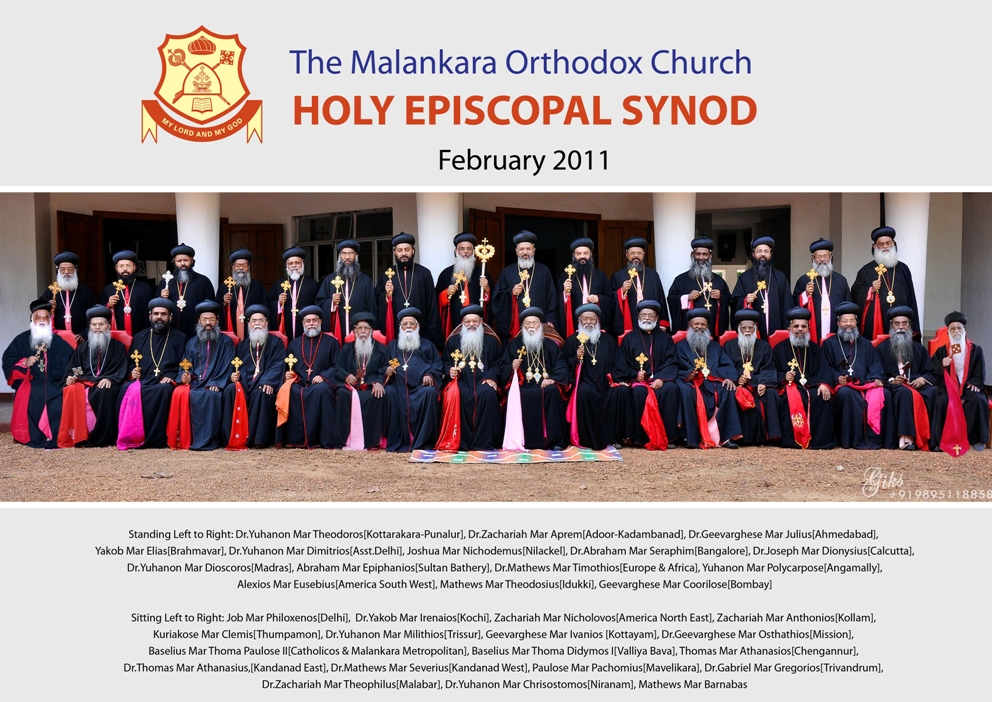
| Holy Episcopal Synod | Home |

THE HOLY EPISCOPAL SYNOD
The Episcopal Synod with the Catholicos as its president is the
apex body of all bishops. The authority of the synod is final
and binding. It has exclusive rights and privileges in the
matter of upholding the faith of the church, its discipline and
order of Apostolic Succession. As regards temporal matters the
church is guided by the Malankara Syrian Christian Association.
H. H. Baselius Marthoma Paulose II B’day: Aug. 30, 1946 (Catholicos and Malankara Metropolitan) Catholicate Palace, Devalokam, Kottayam - 686 038 Ph: 0481 2578234 2578500 2570569 (Fax)
(KOTTAYAM CENTRAL) Dio. Secretary: Rev. Fr. Mohan Joseph
KNANAYA DIOCESE is now directly administered by the Malankara Metropolitan.
H. H. Baselius Marthoma Didymos I B’day: Oct. 29, 1921 Catholicate Palace, Devalokam, Kottayam - 686 038 Ph: 0481 2578234 2578500 2570569 (Fax)
H. H. Baselius Marthoma Paulose II B’day: Aug. 30, 1946
(Kunnamkulam) Bishop's
House, Arthat, Kunnamkulam-680 521 Dio. Secretary: Rev. Fr. Joseph Tholath Ph: 04885 274442
H. G. Dr. Geevarghese Mar Osthatheos B’day: Dec. 9,1918 (Senior Metropoltan) Bethany Aramana, Tiruvalla-689 101 Ph: 0469 2701357 2603357 0479 2302473 2342709 (Fax)
H. G. Dr. Joseph Mar Dionysius (Calcutta) St. Thomas Asram, P.B. 24, Kailas Nagar, Bhilai, Durg. Ph: 0788 2285309 2286882 (Fax) Dio. Secretary: Rev. Fr. Dr. Abraham Oommen
H. G. Dr. Mathews Mar Themothios (EUROPE & AFRICA) E-Mail: thimothiosmathews@gmail.com
H. G. Mathews Mar Barnabas B’day: Aug. 9, 1924 (NORTH EAST AMERICA) Indian Orthodox Church Centre, 80 34 Commonwealth BLVD, Bellrose, N Y - 11426 - 1842 US. Ph: 718 831 1247 718 470 9844 716 470 9219 ( Fax ) Dio. Secretary: Rev. Fr. Philipose Philip Ph: 989 466 2613
H. G. Zacharia Mar Anthonios B’day: Jul. 19, 1946 (KOLLAM) Bishop's House,Cross Junction, Kollam - 691 001 Ph: 0474 2743535 2746900 ( Fax) 0471 2442509 Dio. Secretary: Rev. Fr. John Chacko
H. G. Kuriakose Mar Clemis B’day: Jul. 26, 1936 (THUMPAMON) St. Basil Aramana, Pathanamthitta-689 645 Ph: 0468 2222243 2325942 Dio. Secretary: Rev. Fr. Titus George Ph: 0468 2223788
H. G. Thomas Mar Athanasios B’day Apr: 3, 1938 (CHENGANNUR) Bethel Aramana, Chengannur - 689 121 Ph: 0479 2451331 2453310 Dio. Secretary: Rev. Fr. Mathew Varghese Ph: 0479 2362311
H. G. Geevarghese Mar Ivanios B’day: Nov. 14, 1940 (KOTTAYAM) Kuriakose Mar Gregorios Diocesan Centre, Kottayam Ph: 0481 2564329 2505431 Dio. Secretary: Rev. Fr. P. K. Zachariah Ph: 0481 2701462
H. G. Dr. Thomas Mar Athanasius B’day: Jun. 28, 1952 (KANDANAD EAST) Bishop's House, Muvattupuzha Ph: 0485 2832401 2833401 Dio. Secretary: Rev. Fr. Abraham Karamel
H. G. Dr. Yuhanon Mar Milithios B’day: Jul. 4, 1954 (TRISSOOR) Gethsemon, Mannuthy, Trissoor - 680 651 Ph: 0487 2371039 2371748 (Fax) Dio. Secretary: Rev. Fr. Mathew Jacob Ph: 0492 2343927
H. G. Abraham Mar Ephiphanios (SULTAN'S BATTERY) Nirmalagiri, Poomala, S. Battery-673 592 Ph: 04936 220969 Dio. Secretary: Rev. Fr. Zacharia Veliyathu
H. G. Dr. Jacob Mar Iraneus B’day: Aug. 15, 1949 (KOCHI) Sion Seminary, Koratty East, Chalakudy-680 308 Ph:0480 2732023, 2734818. e mail:sionseminary@satyam.net.in Dio. Secretary: Rev. Fr. Sunny Varghese Punnachalil
H. G. Dr. Mathews Mar Severius B’day: Feb 12, 1949 (KANDANAD WEST) Mar Pachomius Mount, Meempara - 682 308 Ph: 0484 2760286 2763025 0481 2567363 Dio. Secretary: Rev. Fr. Dr. O. P Varghese
H. G. Job Mar Philoxenos B’day: may. 8, 1939 (DELHI) Delhi Orthodox Church Centre, Thuglaqabad Institutional Area, New Delhi-110 062 Ph: 011 29956417 29955203 29958975 (Fax) Dio. Secretary: Very . Rev. M.S. Zacharia Ramban
H. G. Geevarghese Mar Coorilos B’day: Oct.7, 1949 (MUMBAI) Orthodox Church Centre, Sector 10, Vashi, Navi Mumbai-400 703 e mail: orthodox77@hotmail.com Ph: 022 27663427 27650876 (Fax) Dio. Secretary: Rev. Fr. T. E. Issac
H. G. Paulose Mar Pachomius B’day : Jan. 26, 1946 (MAVELIKARA) M. S. Seminary, Thazhakkara, Mavelikara - 690 102, Ph: 0479 2309900 Dio. Secretary: Rev. Fr. Mathai Vilanilam Ph: 0479 2303416
H. G. Dr. Yuhanon Mar Dioscoros B’day: April 8, 1965 (CHENNAI) Bishop's House, 56 Surapet Main Road, Vinayakapuram, Madras - 600 099 Ph: 044 25561897 25560645 Dio. Secretary: Rev. Fr. M. K. Kurian
H. G. Zachariah Mar Nicholovos B’day: Aug.13, 1959 (America Asst.) 13 Pelham Ave # 5 Nanuet NY 10954 USA Ph: 845 627 5816 845 627 0850 (Fax)
H. G. Dr. Gabriel Mar Gregorios B’day: Feb. 10, 1948 (Tiruvananthapuram) Orthodox Church Centre, Ulloor, Medical College P.O., Trivandrum - 695011 Ph: 0471 2442509 Dio. Secretary: Rev. Fr. Baby Thomas
H. G. Dr. Zachariah Mar Theophilos B’day: Aug. 17, 1952 (MALABAR) Mount Hermon, R.E.C. P.O., Kozhikode-673 601 Ph: 0495 2287278, 2288278 (Fax) 0481 2578500 Dio. Secretary: Rev. Fr. Geevarghese Ponnola
H. G. Dr. Yuhanon Mar Chrisostamos B’day: Jan..7, 1955 (NIRANAM) Bethany Aramana, Tiruvalla-689 101 Ph: 0469 2701357 2603357 0479 2302473 2342709 (Fax) Dio. Secretary: Rev. Fr. Alexander Abraham
H. G. Mathews Mar Theodosius B’day: Sept. 15, 1955 (IDUKKI) Gethsemon Aramana, Chakkupallom, Kumily - 685 509 Ph: 04868 282248 Dio. Secretary: Rev. Fr. George Varghese
H. G. Yuhanon Mar Policarpose B’day: March 30, 1953 (ANKAMALY) Thrikkunnathu Seminary, Aluva Dio. Secretary: Rev. Fr. Mathai Edayanal
H. G. Geevarghese Mar Coorilos B’day: Oct.7, 1949 (AHMEDABAD ASST.)
H. G. Alexios Mar Eusebios B’day: Sept. 5, 1964 (SOUTH WEST AMERICA)
3703 Chesterdale Dr., Ph: 281 403 0670 E-Mail: mareusebius@gmail.com
H.G.
Geevarghese Mar Yulios Birth Day: May 17, 1967
St. Mary's
School Campus, Naroda-Nicol Road, Ahmedabad - 382330
Ph: 078295
61008, 94479 63528
E-Mail:
hgyulios@gmail.com
Malankara Syrian Christian Association
Malankara Metropolitan Trustee: H. H. Baselius Mar Thoma Didymos I Catholicate Palace, Devalokam, Kottayam - 686 038
Priest Trustee: Rev. Fr. Dr. Johns Abraham, Konattu, Pampakkuda P. O. Ernakulam Dist. frkonat@gmail.com
Lay Trustee: Sri. M. G. George Muthoottu, 702 Charmwood Village. Royal Retreat, Surajkund Road, Faridabad, Haryana. E-mail:mggm@muthootgroup.com
Association Secretary: Dr. George Joseph, Catholicate Aramana, Devalokam, Kottayam
|